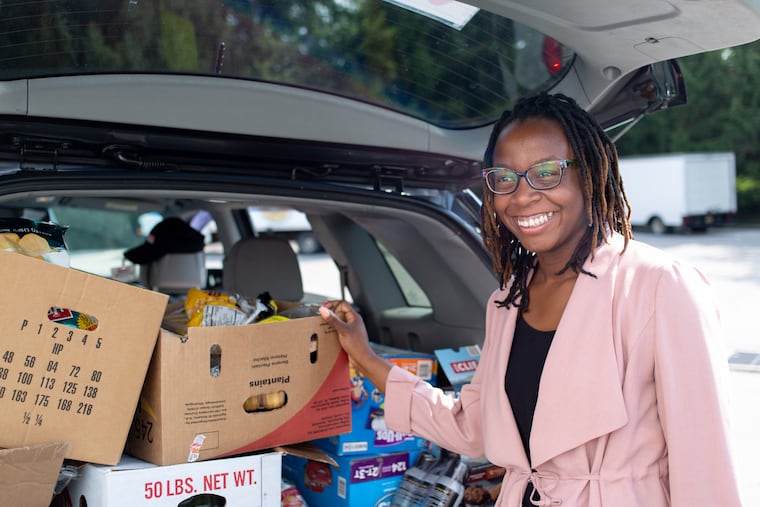Got a smartphone, a car, a big heart and one hour to spare? You can be a hunger hero
Philly Food Rescue rescues surplus food and redirects it to organizations that serve households in need.

On a recent Monday morning, Shontae Smarr pulled up to Center City’s Snap Kitchen and began shuffling bags of food out of the upscale grab-and-go market into her silver Toyota Camry. After filling the car’s trunk and backseat with lentil Bolognese, grass-fed beef taco hash, sesame ginger spinach salad, and other packaged meals, Smarr hopped into the driver’s seat, opened her phone, and clicked on an icon labeled “Philly Food Rescue.”
The app revealed the driving directions to Smarr’s next destination, Bebashi, a sexual health and hunger-relief nonprofit. There, less than two miles away, Smarr dropped off the food. In doing so, she helped save hundreds of dollars’ worth of food, and dinner for dozens of Bebashi clients, from landing in the trash.
“Our goal is to encourage more people to get involved in efforts to eliminate hunger, and to make it as simple as calling an Uber,” says Smarr, the director of Philly Food Rescue.
Launched in October 2018, Philly Food Rescue is a program within nonprofit Uplift Solutions with a mission to rescue surplus food and redirect it to organizations that serve households in need. The program is an expansion of one started in Pittsburgh under organization 412 Food Rescue, which launched its app in November 2016 and has since recovered more than 6 million pounds of food.
At its core is a smartphone application through which volunteers can sign up for one-time or weekly food rescues. Open the app, and a map appears showing area donor locations that have food for rescue. A tap on each location pulls up a window listing the required rescue time frame, exact pickup and drop-off addresses, and an estimate of how much food will be transported. There’s also a button that reads “Claim This Rescue.”
“Sometimes people will get a rescue notification, and the locations are so close that they do it on their lunch break,” says Smarr, noting that donors are purposely matched to recipients located within a five-mile radius.
» READ MORE: Life goes on after a heart transplant, she says. And it’s ‘insanely beautiful.’
Philly Food Rescue has rescued nearly 200,000 pounds of food since its start. That equates to more than 240,000 meals, distributed to nonprofits including day-care centers, schools, housing sites, churches, soup kitchens, and food pantries. Currently, the organization’s largest partnership is with the Philadelphia Housing Authority (PHA). More than a dozen PHA housing sites receive food, six of which receive drop-offs on a weekly basis.
“The food is viable, but unsalable, food that most often would’ve gone to the garbage,” says Smarr. “It can range from items that are reaching their sell-by date, to holiday cookies that are no longer relative, to food left over from an event or from a restaurant at the end of the night.”
Roughly one in five Philadelphians struggle with hunger, according to a 2018 report from the nonprofit Hunger Free America, using data from the U.S. Department of Agriculture. Meanwhile, the USDA estimates that over one-third of all available food in the United States goes to waste. At the retail and consumer levels, that corresponds to about 133 billion pounds per year.
“Surplus food is part of the nature of a grocery business — sometimes too much product is ordered, or you bring in items like a bruised apple that, even though it’s fresh, won’t get picked off the shelf,” says David Deets, director of store development for Brown’s ShopRites. “We were already donating to a lot to Philabundance, but now with Philly Food Rescue’s technology, we have seven-day-a-week pickups, which is critical. Food is being redistributed immediately, while it’s still super-nutritious.”
ShopRite is among two dozen Philly Food Rescue donors, which have included convenience stores like Wawa, restaurants such as Chick-fil-A, and caterers like DiBruno Bros.
“There is so much food out there, and we can all do our part,” says Leah Lizarondo, CEO and cofounder of 412 Food Rescue. “We want this program to be a part of every city. It allows citizens to really take action in solving an existing problem.”
Around 370 people have downloaded the Philly Food Rescue app, available to iPhone users in the App Store and Android users in the Google Play store. In Pittsburgh, the user number is closer to 7,400 for its 412 Food Rescue app, and Philly Food Rescue hopes to see similar engagement success as it amps up publicity efforts. The organization is on track to launch a new website by the end of this month, at which point it will make its first official public announcement about its mission.
“Rather than sitting around posting photos of ourselves and our dogs, here’s this platform we can use on our phone to make a real difference in people’s lives,” says Sam Milkman, 56, a weekly Philly Food Rescue volunteer. “All parties involved are happy to be putting the food to good use, and so you end up walking away feeling a little brighter, knowing that you did something good for the world. What better use for an hour or so of your time?”